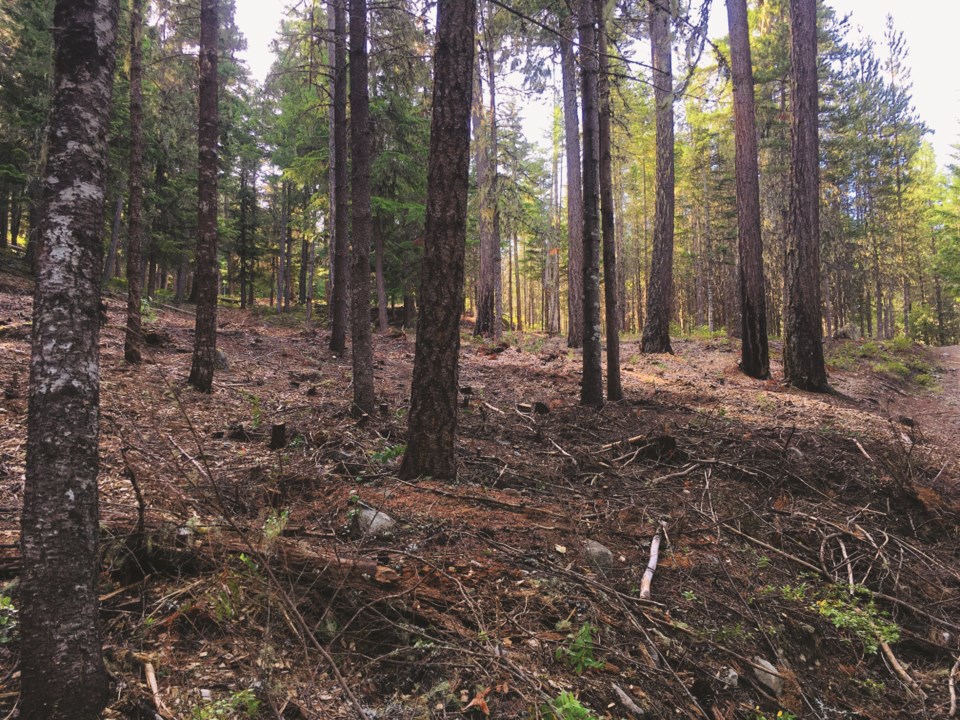Some competing schools of thought concerning wildfire mitigation are clashing in Whistler.
In a letter to council in early May, forester Rhonda Millikin, also a member of Whistler’s Forests and Wildands Advisory Committee (FWAC), requested a stop to fire thinning at Lost Lake and in other Whistler parks, positing that Whistler’s forests are “inherently resilient” and different from other dry, fuel-driven forests.
“One of the major predictors of forest fire is snowmelt,” wrote Millikin, who spent 35 years working for the federal government, first as a terrestrial ecologist with Forestry Canada and then with Environment and Climate Change Canada.
On April 30, Millikin conducted a 4.5-hour study of the effect of fire thinning in Lost Lake on snowmelt.
“The results point to decreased snow and decreased soil moistures where thinning has occurred,” she wrote.
“As the literature and forest ecology experts suggest, fire thinning in our forest type will INCREASE fire risk.”
At the July 7 meeting of Whistler’s Committee of the Whole, Bruce Blackwell of B.A. Blackwell and Associates—the guiding vision behind Whistler’s wildfire mitigation strategies for the past 10 years—addressed Millikin’s letter.
In terms of the effectiveness of wildfire fuel reduction, there is no published science on fuel treatment effectiveness specifically, Blackwell noted.
“But we know from numerous examples in B.C., Canada and the U.S. that it limits fire growth, it reduces fire severity,” Blackwell said.
“One of the big features of fuel treatments is it makes it safe for firefighters to access some of these areas, and it aids in fire suppression by allowing retardant or bucketing or other means of fire suppression, to get down on the ground and actually change the fire behaviour.
“And really that’s what we’re doing by removing fuel—the focus is to change the forest fuel characteristics to reduce both the risk of ignition and the spread of, and ignition into, the canopy.”
It’s difficult to capture changes in fire behaviour as it moves from an unthinned stand to a thinned stand, Blackwell added, noting that you need instrumentation and in-stand cameras to truly observe the measurable effects of fire.
“Just to follow up on that, we are basing our decisions on scientifically understood behaviour in different types of forests … and hoping at some point to get evidence of forests similar to ours?” asked Mayor Jack Crompton.
Blackwell used the analogy of a campfire increasing in heat as you add more logs.
“If we don’t take some of this fuel out of these forests, they are going to burn at an intensity level that potentially destroys infrastructure and homes … and they will also sterilize the site,” he said. “If you look at what’s been happening in these hot fires, you will not get a vegetation response. All these attributes that we’re talking about protecting—old growth, habitat—they will be sterilized.”
One need only imagine the face of Whistler Mountain burning, and the resulting impacts on the visual scenery, to grasp the necessity of the work, Blackwell said.
“Honestly I don’t think we need scientific measure to understand where we’re going to go with this,” he said, adding that fire science is built on the “fire triangle” of heat, oxygen and fuel.
“The only thing we can control in anything we do is treating the fuel. If we don’t remove the fuel, we’re going to see significant fire behaviour under these dry conditions that’s going to damage valleys at risk. It’s as simple as that.”
But many, like Millikin, question the necessity of fuel thinning, and the visual impact on the landscape.
“Why have we cut down so many trees in Lost Lake?” asked Councillor Ralph Forsyth.
“It’s quite shocking to people when they happen upon it.”
The thinning work aims to open the canopy and reduce ladder fuels, Blackwell explained, adding that the majority of trees that remain are largely resistant to fire.
“So if we have a surface fire in there, we expect that they’ll survive, and honestly, councillor, I believe that within the next two years we’re going to see more understory vegetation that’s going to be very pleasant to look at,” Blackwell said, adding that he’s also cognizant of people smoking and possibly causing ignitions in high-use areas like Lost Lake.
“I ride on Tin Pants all the time, I have a home in Whistler, so I have as much stake in this as anybody, and I’m very cognizant of how people feel about it,” he said. “The jury is out, but I believe that most people will be accepting of what we’ve been trying to do.”
The economics of investing in mitigation are clear, Blackwell added, noting that the Fort McMurray fire of 2016 amounted to losses of $9 billion dollars.
“I did the fire management plan for Fort McMurray in February of 2015, and I regretfully can say that we failed. We didn’t move fast enough, act fast enough. The fire that summer basically destroyed that town,” Blackwell said.
“Whistler is as vulnerable as Fort McMurray and the economic, social, environmental impacts would be similar.
“So I have no qualms stating that I feel this is important, valuable work that is no different than an insurance policy.”
While Pique was unable to connect with Millikin before deadline, Councillor Arthur De Jong said he had spoken with her, and was working on setting up a meeting.
“We’re going to get FWAC, and invite council, and invite Bruce Blackwell and Rhonda Millikin on a field trip in August,” De Jong said.
“I have a personal interest in getting [them] on the same plot to listen to how they break it down.”




